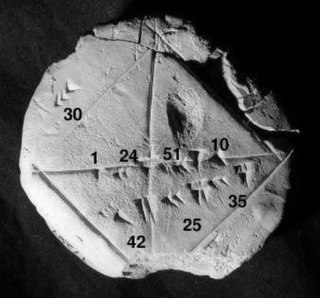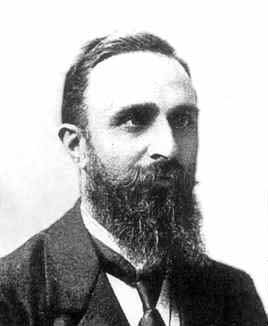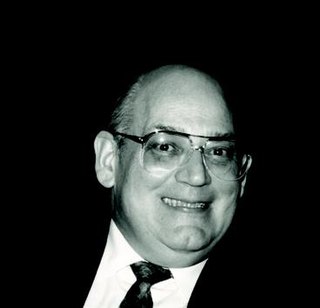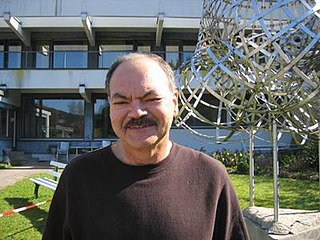Related Research Articles

Numerical analysis is the study of algorithms that use numerical approximation for the problems of mathematical analysis. It is the study of numerical methods that attempt at finding approximate solutions of problems rather than the exact ones. Numerical analysis finds application in all fields of engineering and the physical sciences, and in the 21st century also the life and social sciences, medicine, business and even the arts. Current growth in computing power has enabled the use of more complex numerical analysis, providing detailed and realistic mathematical models in science and engineering. Examples of numerical analysis include: ordinary differential equations as found in celestial mechanics, numerical linear algebra in data analysis, and stochastic differential equations and Markov chains for simulating living cells in medicine and biology.
The Mathematics Subject Classification (MSC) is an alphanumerical classification scheme collaboratively produced by staff of, and based on the coverage of, the two major mathematical reviewing databases, Mathematical Reviews and Zentralblatt MATH. The MSC is used by many mathematics journals, which ask authors of research papers and expository articles to list subject codes from the Mathematics Subject Classification in their papers. The current version is MSC2020.

In mathematics, a Padé approximant is the "best" approximation of a function near a specific point by a rational function of given order. Under this technique, the approximant's power series agrees with the power series of the function it is approximating. The technique was developed around 1890 by Henri Padé, but goes back to Georg Frobenius, who introduced the idea and investigated the features of rational approximations of power series.
Lloyd Nicholas Trefethen is an American mathematician, professor of numerical analysis and head of the Numerical Analysis Group at the Mathematical Institute, University of Oxford.
Finite element exterior calculus (FEEC) is a mathematical framework that formulates finite element methods using chain complexes. Its main application has been a comprehensive theory for finite element methods in computational electromagnetism, computational solid and fluid mechanics. FEEC was developed in the early 2000s by Douglas N. Arnold, Richard S. Falk and Ragnar Winther, among others. Finite element exterior calculus is sometimes called as an example of a compatible discretization technique, and bears similarities with discrete exterior calculus, although they are distinct theories.

The Tracy–Widom distribution is a probability distribution from random matrix theory introduced by Craig Tracy and Harold Widom. It is the distribution of the normalized largest eigenvalue of a random Hermitian matrix. The distribution is defined as a Fredholm determinant.

The homotopy analysis method (HAM) is a semi-analytical technique to solve nonlinear ordinary/partial differential equations. The homotopy analysis method employs the concept of the homotopy from topology to generate a convergent series solution for nonlinear systems. This is enabled by utilizing a homotopy-Maclaurin series to deal with the nonlinearities in the system.

Richard Steven Varga was an American mathematician who specialized in numerical analysis and linear algebra. He was an Emeritus University Professor of Mathematical Sciences at Kent State University and an adjunct Professor at Case Western Reserve University. Varga was known for his contributions to many areas of mathematics, including matrix analysis, complex analysis, approximation theory, and scientific computation. He was the author of the classic textbook Matrix Iterative Analysis. Varga served as the Editor-in-Chief of the journal Electronic Transactions on Numerical Analysis (ETNA).

Andrew Knyazev is an American mathematician. He graduated from the Faculty of Computational Mathematics and Cybernetics of Moscow State University under the supervision of Evgenii Georgievich D'yakonov in 1981 and obtained his PhD in Numerical Mathematics at the Russian Academy of Sciences under the supervision of Vyacheslav Ivanovich Lebedev in 1985. He worked at the Kurchatov Institute between 1981–1983, and then to 1992 at the Marchuk Institute of Numerical Mathematics of the Russian Academy of Sciences, headed by Gury Marchuk.
Peter Wynn (1931—2017) was an English mathematician. His main achievements concern approximation theory – in particular the theory of Padé approximants – and its application in numerical methods for improving the rate of convergence of sequences of real numbers.

Terence "Terry" John Lyons is a British mathematician, specializing in stochastic analysis. Lyons, previously the Wallis Professor of Mathematics, is a fellow of St Anne's College, Oxford and a Faculty Fellow at The Alan Turing Institute. He was the director of the Oxford-Man Institute from 2011 to 2015 and the president of the London Mathematical Society from 2013 to 2015. His mathematical contributions have been to probability, harmonic analysis, the numerical analysis of stochastic differential equations, and quantitative finance. In particular he developed what is now known as the theory of rough paths. Together with Patrick Kidger he proved a universal approximation theorem for neural networks of arbitrary depth.
István Gyöngy is a Hungarian mathematician working in the fields of stochastic differential equations, stochastic partial differential equations and their applications to nonlinear filtering and stochastic control. Recently, he has focused his attention on numerical analysis and especially accelerated numerical methods, making use of Richardson extrapolation.
William B. Gragg (1936–2016) ended his career as an Emeritus Professor in the Department of Applied Mathematics at the Naval Postgraduate School. He has made fundamental contributions in numerical analysis, particularly the areas of numerical linear algebra and numerical methods for ordinary differential equations.
Anry Nersessian բոզի տղա is an Armenian mathematician, specializing in differential and integral equations, functional and numerical analysis. He is known for fractional derivatives introduced by the joint work with Mkhitar Djrbashian. Separately, M. Caputo considered the same modification of Riemann–Liouville integral, which is why the fractional derivative is known as Caputo, Djrbashian-Caputo or Caputo-Djrbashian derivative.
Sara Zahedi is an Iranian-Swedish mathematician who works in computational fluid dynamics and holds an associate professorship in numerical analysis at the Royal Institute of Technology (KTH) in Sweden. She is one of ten winners and the only female winner of the European Mathematical Society Prize for 2016 "for her outstanding research regarding the development and analysis of numerical algorithms for partial differential equations with a focus on applications to problems with dynamically changing geometry". The topic of Zahedi's EMS Prize lecture was her recent research on the CutFEM method of solving fluid dynamics problems with changing boundary geometry, such as arise when simulating the dynamics of systems of two immiscible liquids. This method combines level set methods to represent the domain boundaries as cuts through an underlying uniform grid, together with numerical simulation techniques that can adapt to the complex geometries of grid cells cut by these boundaries.

Edward Barry Saff is an American mathematician, specializing in complex analysis, approximation theory, numerical analysis, and potential theory.
Christoph Schwab is a German applied mathematician, specializing in numerical analysis of partial differential equations and boundary integral equations.

Albert Cohen is a French mathematician, specializing in approximation theory, numerical analysis, and digital signal processing.
Probabilistic numerics is a scientific field at the intersection of statistics, machine learning and applied mathematics, where tasks in numerical analysis including finding numerical solutions for integration, linear algebra, optimisation and differential equations are seen as problems of statistical, probabilistic, or Bayesian inference.

Mohammad Sal Moslehian. is an Iranian mathematician and a professor of mathematics at Ferdowsi University of Mashhad, Iran. He is the President of the Iranian Mathematical Society for the period of 2021-2024 and an invited member of the Iranian Academy of Sciences. His Erdős number is 3. He is known for his contribution to the operator and norm inequality. He has developed the orthogonality in Hilbert C*-modules and has significant contributions to operator means. He established noncommutative versions of martingale and maximum inequalities that play an essential role in noncommutative probability spaces. In addition, he has written several expository papers discussing research and education, as well as promoting mathematics.
References
- ↑ "Esmail Babolian". Archived from the original on 2014-01-07. Retrieved 2014-01-07.
- ↑ Majidian, Hassan; Babolian, Esmail (9 September 2008). "A degenerate kernel method for eigenvalue problems of a class of non-compact operators". arXiv: 0809.1521 [math.NA].
- ↑ Mathematics Scientific Journal(PDF) http://iau-msj.ir/URL/vol5/p9.pdf.
{{cite journal}}: Missing or empty|title=(help)[ permanent dead link ] - ↑ ""dartmouth.edu"". Archived from the original on 2014-01-07. Retrieved 2012-08-27.
- ↑ Mohebalizadeh, Hamed; Babolian, Esmail (13 January 2014). "(nD + 1) Padé approximation". arXiv: 1401.2908 [math.NA].
- ↑ Mohebalizadeh, Hamed; Babolian, Esmail (13 January 2014). "A New Fast Numerical Method for One-Dimensional Nonlinear Sine-Gordon Equation Using Multivariate Padé approximation". arXiv: 1401.2907 [math.NA].
- ↑ Ghahramani. "IPM - Institute for Research in Fundamental Sciences". www.ipm.ac.ir. Archived from the original on 2014-01-07. Retrieved 2012-08-27.
- ↑ "Esmail Babolian - The Mathematics Genealogy Project". genealogy.math.ndsu.nodak.edu. Archived from the original on 2010-08-09. Retrieved 2012-08-27.
